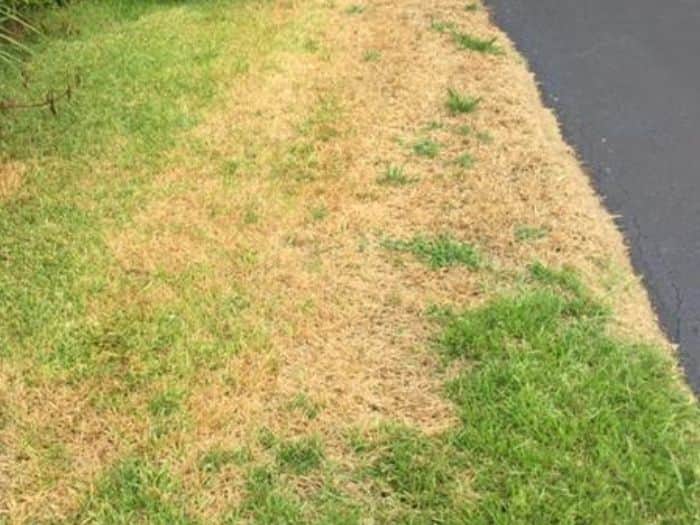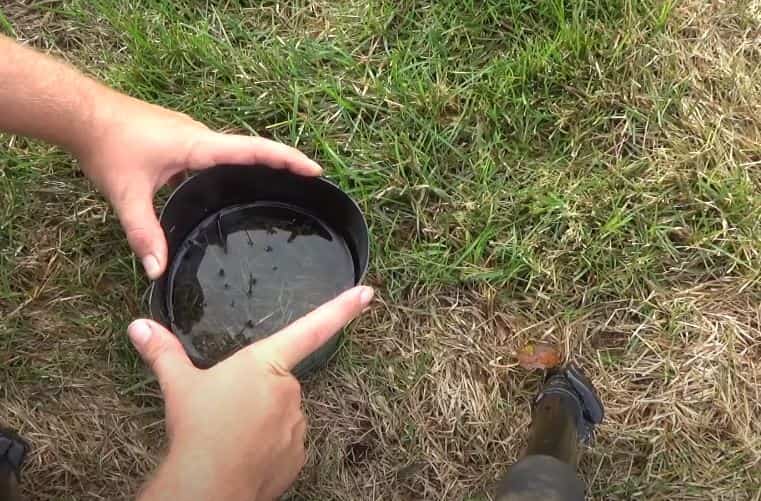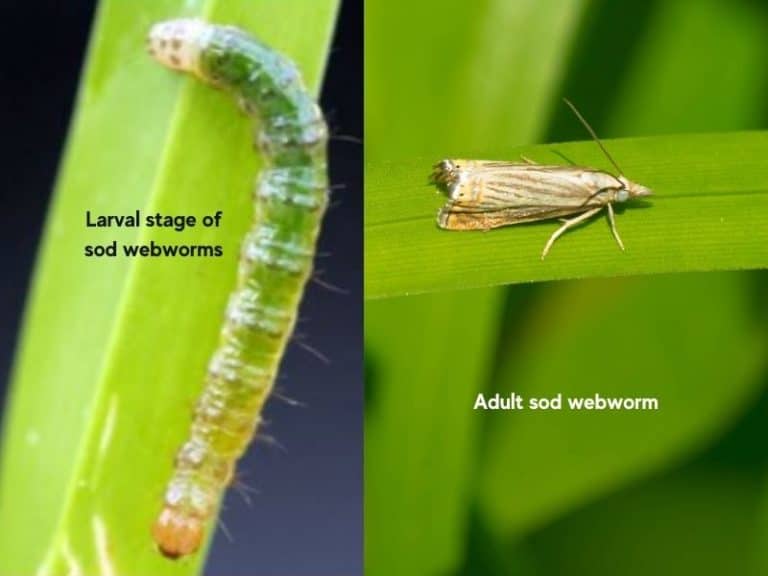How Do You Get Rid of Chinch Bugs in St Augustine Grass?
Have you noticed patchy spots of dead grass on your St. Augustine lawn? Spotting any tiny, black insects creeping on the edges of the affected areas upon closer inspection? Well, you’re most likely dealing with a chinch bug infestation.
To get rid of chinch bugs in St. Augustine grass, apply a chinch bug killer such as Ortho Bugclear and then dethatch the lawn to reduce their population. You can also control chinch bugs naturally by planting flowers near the lawn to attract predators such as spiders, wasps, and minute pirate ants.
Warm-season turfgrasses like St. Augustine grass are usually vulnerable to chinch bug damage due to the dry and hot conditions during this time of the year. In this article, I’ve outlined the signs that the damage on your lawn is due to chinch bugs, as well as how to control these pests.
Signs of chinch bug damage in St. Augustine grass

The last thing you want to do is waste money on chinch bug control products when the pest species that has invaded your lawn is actually a different insect species. This is why you’ll want to confirm that the pests causing damage to your St. Augustine turf are actually chinch bugs.
Here are signs of chinch bugs in your lawn:
Brown spots in the lawn
Effects on the grass- as they suck the fluid from your leaf blades and stolons, these tiny bugs release a toxic substance that causes the grass blades to turn yellow. Over time, the grass blades turn brown and die, with the brown spots constantly expanding outwards as the chinch bugs move on to the healthy grass blades at the periphery of the dead spots.
Chinch bug-infested areas of St. Augustine grass will “have slower growth, turn yellow, then rusty reddish-brown, and die.” – Eileen A. Buss, University of Florida.
These dead spots are likely to appear on your St. Augustine turf once the chinch bug population grows to about 25 of them per square foot.
Therefore- if you have fewer chinch bugs than 25 for every square foot, yet dead grass patches are present on your turf, the damage could be as a result of other factors.
Small black bugs in the lawn

Look out for the physical features of the bugs in your grass. Chinch bugs are hard to spot using the naked eye, as even fully-grown (adult) chinch bugs measure only 3/16-inches long. To spot them, you can use a pair of magnifying lenses.
Adult chinch bugs are black in color, while their white wings each have a triangular mark at the edges. Younger chinch bugs have a reddish-orange hue with white abdominal stripes, and don’t have wings.
Damage on stolons
Chinch bugs favorite feeding spot on a St. Augustine lawn is at the base of the grass blades where lateral runners/stolons usually sprout from.
Summer damage on grass
Time of the year- chinch bugs are typically attracted to hot conditions. As such, they’re most likely to invade your St. Augustine lawn from mid-late summer.
Pro tip: To check for chinch bugs in your St. Augustine grass lawn, take an empty metal can and cut it open on both ends. Stick it into the soil and fill it up with water. If the bugs are present and causing damage, they will float on the water in your can.
Alternatively, you can use a vacuum cleaner to suck out any tiny, moving organisms out of suspicious lawn areas and emptying the content on a white piece of paper to closely examine if chinch bugs are present.
How to kill chinch bugs in your lawn
You can effectively manage chinch bugs on your lawn using biological control or chemical control methods. You can also take a proactive approach to prevent chinch bug invasion by adopting cultural control methods. Each of these control methods for eliminating or preventing chinch bugs on St. Augustine turfs are discussed in detail below:
1. Introduce chinch bug predators (biological control)
You can get rid of chinch bugs on your lawn by introducing biological controls such as spiders, wasps, and minute pirate ants. These predatory insects feed on chinch bugs and can help control their population in your St. Augustine grass lawn.
You can attract these beneficial insects into your lawn by planting flowering plants such as hibiscus in adjacent gardens.
Keep in mind that once you introduce biological controls into your St. Augustine lawn, you should avoid simultaneously using insecticides for the chinch bugs, as the chemical pesticides will kill off the beneficial insects as well. As such, you should avoid using these two control methods at the same time.
2. Apply chinch bug killers (chemical control)
Despite not being eco-friendly, chemical controls are the fastest and most-effective way to get rid of chinch bugs on your St. Augustine turf. For maximum efficiency, you should follow the manufacturer’s instructions when applying chemical insecticides/pesticides on your lawn.
In addition, you may have to apply some of them more than once to completely get rid of the chinch bugs.
Finally, you can try different brands of insecticidal products, as chinch bugs tend to be resistant to some of the pesticide products especially if they’ve been used before.
When using chemical insecticides to kill chinch bugs, you should take the necessary safety precautions to avoid causing harm to yourself or pets and children.
This includes:
- Keep children away from your St. Augustine lawn after spraying it with a chinch bug pesticide until it’s completely dry.
- Wear the appropriate protective gear like chemical-resistant gloves
- Dispose of the chemical containers in accordance with the safety instructions on the container’s labeling.
Cultural Chinch Bug Control
Cultural control entails adhering to the proper lawn maintenance requirements for St. Augustine grass. Remember, most turfgrasses are more capable of resisting pest infestation if they’re healthy and properly maintained.
One cultural control method that we recommend is dethatching, as thick layers of thatch on St. Augustine turfs prevent insecticidal control measures from being as effective as they should be.
Dethatching is commonly done using a rake, but you can also prevent thatch buildup on your St. Augustine lawn by adopting the proper mowing practices, which include mowing at the appropriate time intervals and using mulching mowers. Mulching mowers reduce the need for application of fertilizer or compost, thus minimizing thatch.
Other effective methods for dethatching a lawn where the thatch layer exceeds one-inch in thickness include vertical mowing, lawn aeration, top dressing, and avoiding overwatering. Excessive water in the soil encourages St. Augustine roots to grow shallow, making them more susceptible to chinch bugs. Finally, you can also prevent excessive thatching from attracting chinch bugs into your St. Augustine lawn by avoiding application of excessive fertilizer.
Best chinch bug killer for lawns
You can always count on chemical insecticides to kill off chinch bugs on your St. Augustine lawn. For the best results, you should always check the manufacturer’s instructions on the product labeling, as some of these lawn insecticides require mowing and watering before being sprayed onto the lawn.
However, broad-spectrum pesticides typically have to be applied repeatedly, as they only kill chinch bugs but not their eggs. The subsequent applications are usually to kill off the chinch bugs that hatched from the eggs that weren’t killed during the initial application.
What’s more, chemical pesticides are not eco-friendly and cause harm to the environment. As such, the best chinch bug killer for your St. Augustine lawn would be an eco-friendly alternative- such as diatomaceous earth (DE). Made from pulverized fossils, DE is a natural product that contains sharp, microscopic particles. These particles will pierce the bodies of most insects they come across- including chinch bugs.
Additionally, DE tends to dehydrate chinch bugs that come into contact with it, causing them to die after just a couple days or so. Apart from the eco-friendly aspect, the other factor that makes DE better than chemical insecticides is the fact that repeat applications aren’t necessary. This is because residual DE that remains in the turf is usually enough to kill off any chinch bugs that hatch later on.
What time of year do chinch bugs come out?
Chinch bugs typically come out during the warmer seasons of the year – spring and summer. Fully-grown chinch bugs stay inactive during winter and only start reproducing at the beginning of spring when the weather gets warmer.
Every female adult chinch bugs can lay about 300 eggs, which take only about 14 days to hatch. This is why you’re more likely to start noticing turf damage from late spring- early summer, as the chinch bug population will have grown to at least 25 bugs per square foot at this point.
When chinch bug populations are this large, they overcome the natural defenses of your St. Augustine turf, resulting in visible damage of ever expanding brown patches in your lawn.
Can chinch bugs be transferred by lawn mowers?
Chinch bugs cannot be transferred by lawn mowers since they tend to avoid the upper sections of the grass blades and stay at the base of your turf. I you’re spotting chinch bugs on your St. Augustine lawn and are wondering how they got there, the answer could be by flying or crawling in from nearby lawns.
Also, if you’ve recently transplanted sod or stolon cuttings as sprigs to plant in your St. Augustine turf, it could be that the chinch bugs were carried along with the sod pieces, plugs, or sprigs.
References
- Michael E. Merchant and Dale A. Mott, Texas A&M Extension: Chinch Bug Control in St. Augustine Lawns
- Clyde S. Gorsuch, PhD, Emeritus Faculty, Entomology, Clemson University: Chinch Bugs in Lawns
- Eileen A. Buss, Brianna M. Whitman, and Adam G. Dale, University of Florida, IFAS Extension: Managing Southern Chinch Bug in Warm Season Turfgrasses


